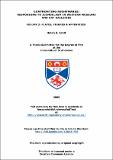Files in this item
Confronting nightmares : responding to iconoclasm in Western museums and art galleries
Item metadata
| dc.contributor.advisor | Gunn, Ann V. | |
| dc.contributor.author | Scott, Helen E. | |
| dc.coverage.spatial | 334 p. | en |
| dc.date.accessioned | 2009-11-20T10:13:33Z | |
| dc.date.available | 2009-11-20T10:13:33Z | |
| dc.date.issued | 2009-11 | |
| dc.identifier | uk.bl.ethos.552289 | |
| dc.identifier.uri | https://hdl.handle.net/10023/788 | |
| dc.description | Electronic version excludes material for which permission has not been granted by the rights holder | en_US |
| dc.description.abstract | It is not an everyday event for an artwork in a museum or gallery to be harmed deliberately by a member of the public. Such acts of iconoclasm do occur more regularly than many people might assume though, and when attacks take place the repercussions can be serious. This thesis examines the ways in which cultural institutions react to this phenomenon, investigating how responses could be improved to tackle it more effectively. The first chapter establishes the context to the discussion by categorising and rationalising the various motives behind iconoclastic crimes. The next chapter concentrates on historical trends of response, using the case of the suffragette iconoclasts to illuminate reactions from across society, before assessing the effects of their endurance. The third chapter broaches new ground in the field of prevention by exploring the access and education approach: a means of forestalling destructive compulsions among the public by promoting engagement with cultural institutions and works of art. The fourth chapter looks at security enhancement: the more traditional answer to iconoclastic offences. It evaluates the options open to museums from a defensive standpoint, but it also discusses the wider impact of implementation on accessibility. The final chapter presents the findings of a postal survey of 250 British museums and galleries undertaken in 2006. The purpose of the survey was to gauge the current nature and extent of the problem, and to determine how contemporary museum professionals deal with it. Although some cultural institutions respond to iconoclasm with considered, sustainable and effective tactics, others would be wise to revise their conduct. This thesis concludes that while instances of iconoclasm will never be eradicated from galleries completely, the threat could be curbed significantly if the museum sector was to make a concerted effort to study its own responses and introduce necessary changes. | en |
| dc.language.iso | en | en |
| dc.publisher | University of St Andrews | |
| dc.rights | Creative Commons Attribution-NonCommercial-NoDerivs 3.0 Unported | |
| dc.rights.uri | http://creativecommons.org/licenses/by-nc-nd/3.0/ | |
| dc.subject | Iconoclasm | en |
| dc.subject | Art | en |
| dc.subject | Vandalism | en |
| dc.subject | Museum | en |
| dc.subject | Gallery | en |
| dc.subject.lcc | N8557.S3 | |
| dc.subject.lcsh | Iconoclasm | en |
| dc.subject.lcsh | Art--Mutilation, defacement, etc. | en |
| dc.subject.lcsh | Museums--Security measures | en |
| dc.subject.lcsh | Art museums--Security measures | en |
| dc.subject.lcsh | Cultural property--Protection | en |
| dc.title | Confronting nightmares : responding to iconoclasm in Western museums and art galleries | en |
| dc.type | Thesis | en |
| dc.contributor.sponsor | Arts and Humanities Research Council (AHRC) | en |
| dc.type.qualificationlevel | Doctoral | en |
| dc.type.qualificationname | PhD Doctor of Philosophy | en |
| dc.publisher.institution | The University of St Andrews | en |
This item appears in the following Collection(s)
Except where otherwise noted within the work, this item's licence for re-use is described as Creative Commons Attribution-NonCommercial-NoDerivs 3.0 Unported
Items in the St Andrews Research Repository are protected by copyright, with all rights reserved, unless otherwise indicated.



